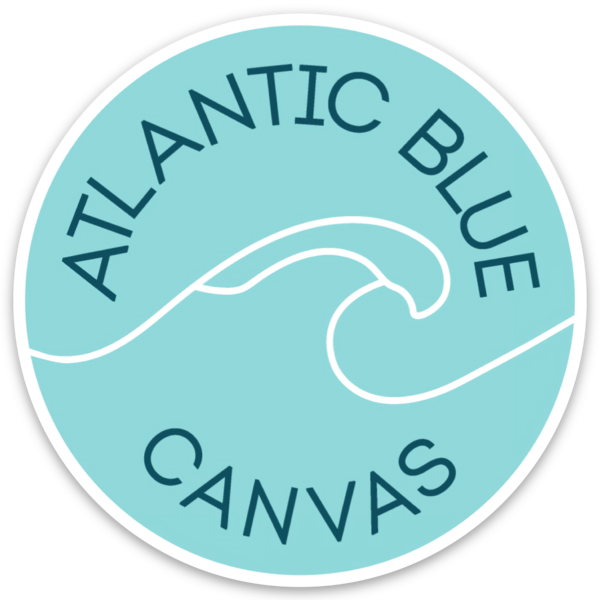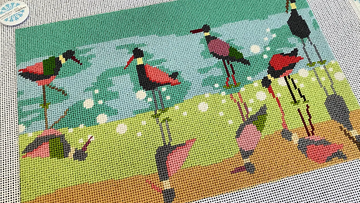Whether you’re new to needlepoint or leveling up your skills, one of the most overlooked (but most important) parts of any design is the background. It’s more than filler—it’s the foundation that shapes how your entire piece looks and feels. In this guide, we break down what makes a great background stitch, share some of our favorite techniques, and offer tips on choosing the right one for your next project.
Key Takeaways:
- Background stitches shape your design’s look, texture, and stitching experience.
- The best background needlepoint stitches balance ease, coverage, and style.
- Discover top stitch types like tent, basketweave, brick, and Parisian for smooth finishes.
- Learn how to choose the right stitch for your canvas, project, or skill level.
- Shop beginner needlepoint kits at Atlantic Blue featuring beautiful backgrounds.
Why Background Stitches Matter
When we talk about needlepoint, it’s easy to focus on the star of the show—the main motif, figure, or lettering. But the background? That’s the unsung hero. It fills the space, sets the tone, and often takes up the most real estate on your canvas. That’s why choosing the right background stitch isn’t just a practical decision—it’s a creative one.
At Atlantic Blue Canvas, our beginner needlepoint kits are designed with both ease and aesthetics in mind. From needlepoint ornaments to full-sized canvases, we know that background work deserves just as much love.
Let’s explore which needlepoint stitches work best for backgrounds, what makes them ideal, and how to incorporate them into your next project with confidence.
What Makes a Stitch Ideal for Backgrounds?
Not all needlepoint stitches are created equal when it comes to background coverage. You want something that:
- Covers efficiently: It should fill space without looking patchy.
- Feels rhythmic: Repetitive motion helps with speed and consistency.
- Uses thread wisely: Some decorative stitches are thread-heavy, which can be fine in small doses, but not across a whole canvas.
- Adds dimension (or stays quietly in the background): Depending on your design, you may want texture or simplicity.
Tip: Match your stitch to your needlepoint canvas mesh size. Finer meshes allow more detailed stitches, while larger mesh canvases benefit from broader, bolder stitches.
If you're new to the craft, our guide on how to choose needlepoint canvas can help you decide what’s right for you.
Top Background Stitches You Should Try
Tent Stitch
- Why it works: Covers evenly, super simple, and easy to control.
- Best for: Solid background fills, needlepoint ornaments, or when you want the design to pop
- Thread use: Low to moderate.
- Pro tip: Keep tension consistent for best results.
- Often included in beginner needlepoint kits.
Basketweave Stitch
- Why it works: Prevents canvas warping, covers smoothly.
- Best for: Large canvases like pillows, wall art, or vintage needlepoint stockings.
- Thread use: Efficient, especially over time.
- Project use: Ideal in basket stitch needlepoint kits for background-heavy designs.
Continental Stitch
- Why it works: Great thread coverage and stability.
- Best for: Clean, small-scale designs or when using tonal threads.
- Thread use: Slightly more than tent stitch.
- Pro tip: Practice this stitch to improve your understanding of how to needlepoint across wider canvas areas.
Binding Stitch
- Why it works: Adds structure and clean edges to sections of background.
- Best for: Ornament edges, coasters, or banner frames.
- Thread use: Moderate.
- Often found in our needlepoint accessories kits and project guides.
Brick Stitch
- Why it works: Creates staggered texture that’s still easy to work with.
- Best for: Backgrounds that need depth without overpowering the focal design.
- Thread use: Medium.
Diagonal Mosaic Stitch
- Why it works: Quick and chic, covers well without much strain.
- Best for: Gradient backgrounds or modern stitch art kits.
- Thread use: Slightly heavier.
Parisian Stitch
- Why it works: Elongated, structured lines that offer visual rhythm.
- Best for: Artistic backgrounds, wall hangings, and expressive mixed media designs.
- Thread use: Medium to high.
Each of these stitches brings a distinct energy to your background, so don’t be afraid to test different types before committing.
Atlantic Blue Picks: Kits That Feature Beautiful Backgrounds
We curated these kits specifically with backgrounds in mind, so you can learn how to needlepoint while mastering real-world application of stitches:
- Compact project for tent and binding stitches.
-
Perfect for short weekend crafting sessions.
- Great for basketweave and mosaic stitch backgrounds.
- Modern, fresh, and full of tonal color layers.
- A classic design with soft floral tones and ample space for experimenting with stitch types.
Shop All Beginner Needlepoint Kits
Tips for Stitching Backgrounds Like a Pro
Whether you're just learning how to needlepoint or exploring new needlepoint types, these techniques will make your background process smoother:
- Don’t pull too tight: Consistent tension prevents puckering or distortion.
- Use longer threads wisely: More efficient, but avoid going beyond 18 inches to reduce fraying.
- Start from the edge and work inward: It helps guide alignment and shape.
- Match mesh count to detail: Finer canvases = finer stitches.
- Frame it up: Using needlepoint accessories like hoops or stretcher bars can stabilize your canvas for background areas.
For tools like tapestry needles, scissors, or storage options, check out our full line of needlepoint accessories.
FAQs
What is the best stitch for needlepoint background?
Basketweave is widely favored for its even coverage and canvas-preserving effect. Tent stitch is also popular for its simplicity.
Which background stitch uses the least thread?
Tent stitch is the most economical in thread consumption.
Can I use different stitches in one background?
Yes! Mixing needlepoint stitches can add depth and creativity to your project.
What’s the easiest needlepoint stitch to learn?
The tent stitch. It’s simple, repetitive, and a great way to understand stitch structure.
Should I start with the background or the foreground?
It depends on your style. Some start with the background to “set the stage,” while others fill it in last to finish off the piece.
Conclusion: Let the Background Shine
When people ask, What is needlepoint, they usually think of centerpieces or detailed figures. But the background? That’s the quiet power behind every standout canvas. It’s the part of your needlepoint journey that teaches patience, rhythm, and design harmony.
From brick to basketweave and beyond, mastering your background technique enhances every project. Whether you’re working on a personalized gift or creating needlepoint ornaments, your background should reflect just as much intention as your main motif.
Ready to give your canvas the background it deserves? Explore beginner needlepoint kits, canvas, and tools at Atlantic Blue





